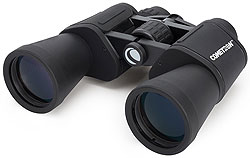7x50 vs 8x56 Binoculars for Astronomy & Daytime Surveillance
Which is Best? Part of the BBR BinoWars Series, in this article I take an in-depth look at the main differences between 7x50 vs 8x56 Binoculars with examples, full reviews and recommendations to help you choose the best binocular for your particular needs, be that for astronomy at night or daytime surveillance uses like wildlife observation, hunting, birding, security, survival, and even marine uses.
However, before diving in, it is imperative that you completely understand what we mean when we refer to an 8x50 and 7x50 binocular (or indeed any other configuration), if not, first take a moment to read my guide to what the Numbers Mean on a Binocular.
When it comes to binoculars that have larger than “standard” objective lenses, yet magnifications that are still fairly moderate, two of the most talked-about are the 7x50 and 8x56 configurations.
Main Differences
Size & Weight
Larger lenses directly influence the size (outer dimensions) and as a result also somewhat indirectly to the overall weight of a binocular as larger lenses not only require more glass to make them but also larger bodies to hold them in, which obviously also requires more material to make.
Therefore it is understandable that most 8x56mm binoculars are going to be bigger and heavier than an equivalent 7x50mm.
How Much Difference?
In the sentence above I highlighted the word equivalent firstly because a cheap 8x56 binocular manufactured using a polycarbonate plastic as the main material for the chassis, eye-piece housings, eye-cups and focus wheel is very likely going to weigh less than a high-end instrument using magnesium and other metals for these components.
Likewise, a 7x50 Porro prism binocular can have larger dimensions than an 8x56 Roof prism design. Thus it is important to compare like-for-like.
If we do, I have found that whilst there is a difference, the discrepancy in sized and weight between the two is really not that massive and it is easy to mix them up, or assume they have the same configuration before looking more closely at the details.
Indeed, as you can see from the table above, once you have made the decision to step-up from a “standard” 42mm binocular I would not be too worried about the variation between 50mm and 56mm instruments that is unless you are right at the edge of what you deem to be your maximum acceptable size and weight.
Although here I would just like to add a caveat: For uses like “hand-holding” astronomy where you are holding the binocular for long periods at an uncomfortable angle, for some users, the small weight increase that you get with a 56mm binocular may be worth keeping in mind.
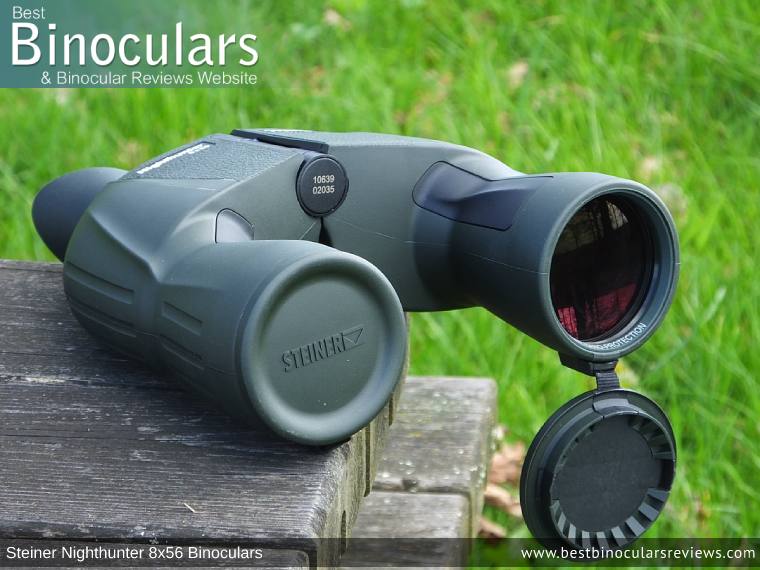
Light Gathering & Image Brightness
Assuming that the level of glass and coatings used is also the same, the larger surface area of the 56mm lenses on an 8x56 binocular means that they are able to capture more light than the 50mm ones on a 7x50.
More light potentially equates to a brighter as well as a better quality view.
However, as we are comparing binoculars with different magnifications, things are a little more tricky:
- Firstly higher magnifications require thicker glass in the ocular lenses which results in a reduced level of light transmittance through them (once again we are assuming all else is equal) – however as the variation between 7x and 8x is very minimal and thus the difference in thickness of the lens elements is likewise very minimal, thus in my experience this is not something worth stressing over in this example.
- Secondly, we also need to take the size of the exit pupil created by the two different configurations into account as a large exit pupil can often lead to an observable improvement in brightness, especially in low light:
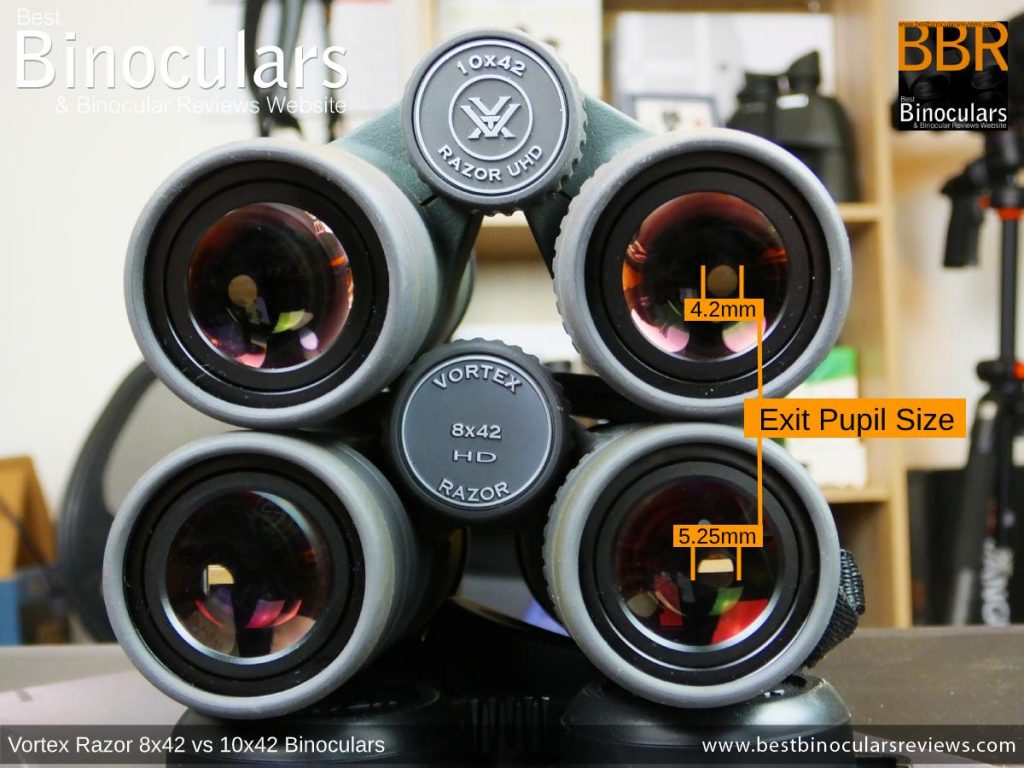
Low Light Performance
Here it is important to understand what the exit pupil is and how it affects how we perceive image brightness in low light. If you are unsure, I highly suggest that you first take a quick look at my complete guide to the exit pupil before continuing.
So let us now consider this comparison:
- 7x50 binoculars create 7.14mm exit pupils (50/7)
- 8x56 binoculars create 7mm exit pupils (56/7)
So once again, the difference between the two different setups is very minimal and thus, once again, based on the theory and indeed my own personal experience whilst testing, comparing and reviewing a host of different 7x50 and 8x56 binoculars, it is very difficult and often impossible to notice any variance in image brightness and low light performance (as long as the instruments are of very similar quality).
Image Detail
In general, higher magnifications allow you to “see further”, although as you can see galaxies that are hundreds or even thousands of lightyears away with 10x, 8x and yes, even 7x binoculars, I prefer to think of it like this: higher magnifications deliver greater image detail in objects viewed at the same distance away.
However, the available light also plays a factor in how much detail you can see:
In daylight when there is a good amount of ambient light, your eye pupil size will be only about 2 to 3mm in diameter. Under these conditions, magnification is the principal factor in image resolution. At night, with the eye pupil dilated to about 6mm to 8mm, the aperture size (objective lens size) and the resulting exit-pupil size is the dominant factor.
In twilight: Both of these factors play a part in image resolution. Indeed many manufacturers will list a binoculars twilight factor that compares binocular performance under these particular conditions.
The twilight performance is just a rough guide, but basically you can work out by first multiplying the magnification by the objective lens diameter and then finding the square root of the result:
- 7x50 binoculars have a twilight factor of 18.7
- 8x56 binoculars have a twilight factor of 21.2
As a twilight factor of about 17 or more is usually recommended as the amount needed to achieve a good level of detail in low light, the 8x56 once again has the advantage in this circumstance.
Image Stability
If you are using your binoculars without any sort of stabilization (be that via a tripod, monopod or onboard image stabilization), another important factor and one that greatly influences the amount of detail or how clearly you can see an image is how still you can keep the image.
Magnification magnifies any movement you make and so it is harder to maintain a steady, shake-free image with a higher-powered binocular and thus even though high powered, long-range binoculars can technically deliver more image detail, you sometimes cannot actually keep the view still enough to benefit from it.
In can also be harder to keep a large heavy binocular still versus a small lightweight one. This is especially true for long periods of observation due to muscle fatigue.
However, here once again the difference between the 7x and 8x magnifications is very minor so this is not really a factor (for most uses) and whilst they are certainly heavier than the average 42mm binocular, most reasonably fit adults should be able to effectively handhold both a 7x50 and 8x56 binocular without too much difficulty.
Having said this there are some uses where image stability, even with low powers can be an issue. See the marine and astronomy sections below.
Field of View
At any given distance, the more zoomed in you are (the higher the magnification), the less of the wider picture that you can see than if you were more zoomed-out:
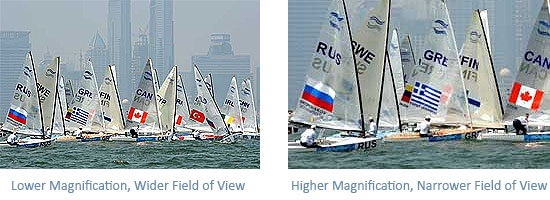
So in general, the higher the magnification, the narrower the field of view.
A wide view is just about always desired but is especially important if:
- You are searching over a large expanse looking for a small object
- Need to very quickly locate an object and keep it in your view
- Are trying to follow a fast-moving object, especially true at close range and if its movement is erratic
8x56 vs 7x50: Which is Best For:
Astronomy
Large, high powered binoculars for astronomy like a 15x70, 20x80 or even a 25x100 are great for increasing the detail and/or reaching deeper into space, however, the downside is they are large and heavy and thus the use of a tripod is essential.
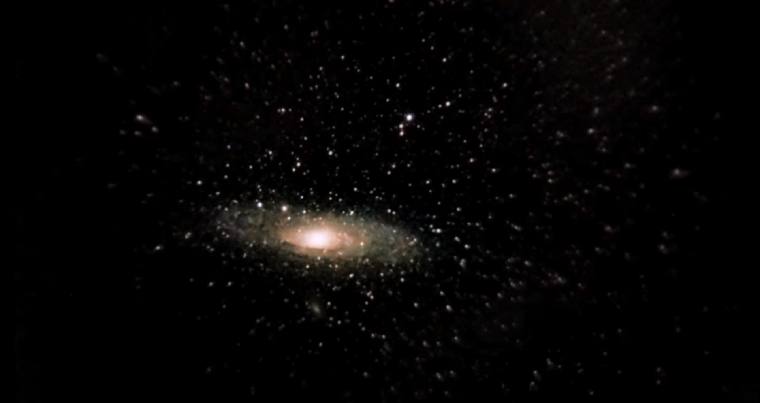
7x50 Binoculars For Astronomy
So along with the wide field of view, the beauty of using 7x50 binos for astronomy and why it is a popular configuration for this use is because they gather a good amount of light (good for use at night), have a large exit-pupil (good for use at night) and, for most users, lightweight enough to use from the hands without the need of a tripod. The low 7x power also helps with this by making it easier to keep the image shake-free.
On top of this stargazing with binoculars from the hands is more about wide views and being able to easily navigate the night sky, find stars and enjoy whole clusters and constellations than viewing single objects in fine detail. So here the very wide views you get from a 7x magnification is certainly an advantage.
8x56 Binoculars For Astronomy
However, and not to be outdone, compared to a 7x50, an 8x56 bino will give you with a little more image detail, a little further reach into space, they have a better twilight factor and with their large lenses and 7mm exit pupil, they do they make a good option for binocular astronomy from the hands.
7x50 vs 8x56 Binoculars For Astronomy
Thus as you can see, to choose between these configurations for Astro use is really tough and over the years, I have had very good experiences with both
But if I had to choose between the two and my only use for them was astronomy, then my choice would be as follows:
If I also had a larger, more higher-powered binocular fixed to a tripod or an Astro telescope to complement these wide-angle binoculars, then the reduced field of view, increase in image-shake and the small increase in weight would probably lead me to opt for the 7x50 over the 8x56.
If I did not have another bino or a telescope then I would opt for an 8x56 binocular.
Wildlife Observation & Hunting

For these types of uses where you are observing and/or looking for larger animals, both 7x50 and 8x56 binoculars can be a great option and are especially good for those who often go out to hunt or view wildlife in low light, or who operate in thick forest or woodland areas where the available light is often reduced and the observation distance is relatively close.
So here I don’t think there is a wrong choice, but personally I would usually opt for the 8x56 over the 7x50, that is unless whatever you are usually looking for is particularly fast-moving and/or erratic and at close range and therefore would go for the instrument with the wider field of view, which is likely to be the 7x50.
For long days out in the field, I would also consider getting myself a bino harness, but just making sure that it can accept the larger than standard instrument. For ideas, take a look at my page on the Best Binocular Harness for Hunting and would also recommend the Cotton Skout (see below).
Birdwatching
Similar to wildlife observation: Both are especially good for low light birding.
Out in the Open: 8x56
Then for most general birdwatching out in the open over mid to longer distances, an 8x power is what I personally would go for and thus the 8x56 would be my choice.
But at the same time, I would also invest in a good bino harness that can accept larger instruments, just to take the weight off. Something like the Cotton Skout Binocular Sling Style Harness would be a good option and I have used it with the Steiner 8x56 with great effect.
Closer Range, In Forests: 7x50
If your birding is at closer ranges, especially in locations like thick forests or woodland and you find that you are mostly observing small, fast-moving birds, then a 7x50 would be a great choice and most probably the preferred option of most experienced birders
Boating, Yachting & Other Marine Uses
7x50 Marine Binoculars
Most of the best marine binoculars use a 7x magnification and the main reason being that as you are on an unsteady platform on the water and have to use your binoculars from the hands, the extra stability you get from a lower power is king.
So whilst an 8x56 would not be a terrible choice, the 7x50 would in most circumstances be the better choice.
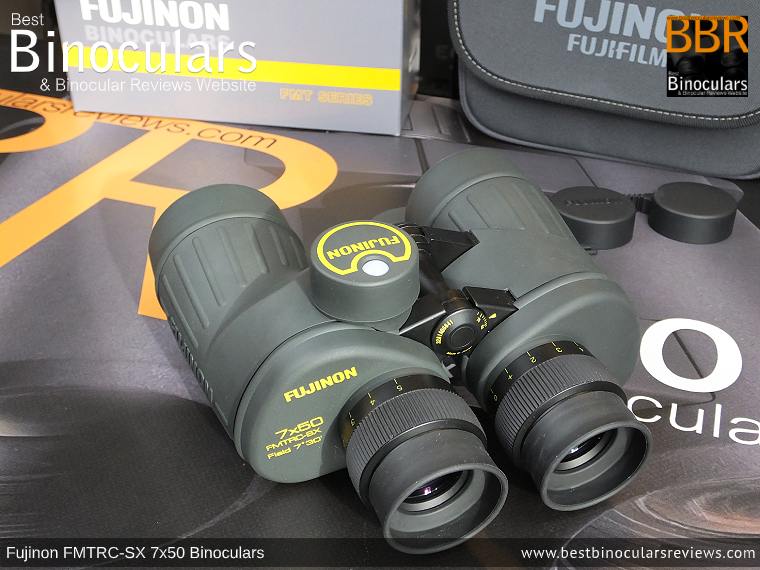
Survival & Security Surveillance
As there is a good chance for both security and survival situations that you may need to use your binoculars in low light, a good performance in these conditions is essential and thus 8x56 and 7x50 binoculars like these with larger than standard objectives and relatively low power that ensure a good sized exit pupil are ideal.
Here I feel that in most security and survival cases you will either want to keep your distance, or the viewing distance to your subject won’t be considered short and so whilst the 7x50 would not be a bad option, I would certainly reach for the 8x56 binoculars.
Recommendations & Reviews
7x50 Binoculars
8x56 Binoculars
Conclusions
7x50 vs 8x56 Binoculars
As is often the case in this BinoWars series, there is no single best option. It all just comes down to your specific needs and what you want to get out of your optics.
Great Low light Performers
In general, both 8x56 and 7x50 binoculars are excellent in low light situations, so from there, you need to dig a little deeper:
- For a wider view, more stability, a slightly smaller size, and lower weight, the 7x50 binocular is the winner
- For more detail (unless you are on a boat or possibly looking at the stars) and a little more reach the 8x56 binocular is the way to go

 Article | Posted by Best Binocular Reviews
Article | Posted by Best Binocular Reviews 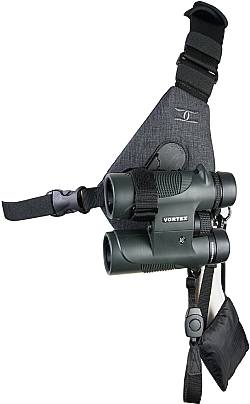

 Categories:
Categories:  Tags:
Tags: 
